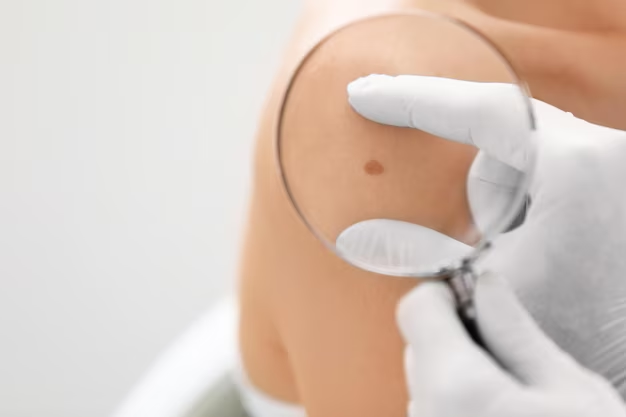How to Recognize Skin Cancer Spots: A Guide to Identifying Symptoms 🕵️♀️
Every day, your skin diligently works to protect you from the sun and other environmental factors. But what happens when it can no longer withstand certain detrimental conditions, like harmful ultraviolet (UV) rays? This is when your skin might start showing signs that you shouldn't ignore. Identifying skin cancer at an early stage can be critical. Understanding what skin cancer spots look like can empower you to seek advice from healthcare professionals quickly, leading to better outcomes.
The ABCDEs of Skin Cancer: A Handy Checklist
One of the most effective ways to evaluate skin spots is to use the ABCDE guide, which highlights key characteristics to be aware of:
A - Asymmetry: If you draw a line through a mole and the two halves do not match, this is asymmetrical and could be a warning sign.
B - Border: Normal moles have smooth, even borders. If the edges are irregular, ragged, or blurred, it might be cause for concern.
C - Color: Look for a variety of colors (such as shades of brown, tan, black, or sometimes patches of pink, red, white, or blue). Even a mole that changes color over time can be suspicious.
D - Diameter: Skin cancer spots are often larger than a pencil eraser (approximately 6mm), though some may start smaller.
E - Evolving: Any change in size, shape, color, or elevation of a spot, or new symptoms such as bleeding, itching, or crusting, signifies potential risk.
Understanding these characteristics can help in the early detection of melanoma, a serious form of skin cancer.
Different Types of Skin Cancer and Their Appearance
There are several types of skin cancer, each with distinct features. Here’s how you can spot each:
Basal Cell Carcinoma (BCC)
Basal Cell Carcinoma is the most common type of skin cancer but also the least likely to spread. Often found in sun-exposed areas, BCC may appear as:
- Pearl-like bumps: These might be pink, skin-colored, or shiny.
- Flat lesions: These are often flesh-colored or brownish.
- Scar-like areas: These might be whitish or waxy, lacking clear borders.
Squamous Cell Carcinoma (SCC)
Squamous Cell Carcinoma is more aggressive than BCC and can appear as:
- Red nodules: Firm and scaly but can also ulcerate.
- Flat lesions: Rough, scaly, and crusted surface, sometimes with central ulceration.
Melanoma
Melanoma is the deadliest form and can develop anywhere on the body, not only in sun-exposed areas. Look for:
- Irregular moles: As described in the ABCDE guide.
- New, unusual growths: These can be brown or black spots, sometimes pink, red, purple, blue, or white.
Other Less Common Cancers
- Merkel Cell Carcinoma: Presents as skin-colored, red, or purple nodules, often found on the face, head, or neck.
- Kaposi Sarcoma: Gives rise to purple or red patches on the skin or mucosal surfaces.
- Cutaneous T-cell Lymphoma: May appear as patches, plaques, or nodules.
Risk Factors That Could Lead to Skin Cancer
Being aware of risk factors can further aid in early detection. Some key factors include:
- Prolonged UV exposure: Sunbathing or using tanning beds frequently.
- Fair skin: Less melanin offers less protection from harmful rays.
- Family history of skin cancer: Genetics can play a role.
- Age: Over time, sun exposure damage accumulates.
- Immune suppression: Those with weakened immune systems might have a higher risk.
What Should You Do If You Spot Something Suspicious?
It’s essential to consult with a healthcare professional if you notice any suspicious changes in your skin. An expert can assess, screen, and, if needed, perform a biopsy to determine the nature of the spot.
Important Actions:
- Regular Self-examinations: Make periodic checks a habit, especially after being in the sun.
- Annual Dermatologist Check-ups: Professional evaluations are crucial.
- Sun Safety Measures: Use sunscreen, seek shade, and wear protective clothing.
Empowering Yourself with Knowledge
While skin cancer can be a formidable adversary, staying informed and vigilantly observing your skin can make a significant difference. Remember to use the ABCDE guide and familiarize yourself with different cancer types and their appearances. Incorporating protective habits in your lifestyle, like applying sunscreen and avoiding peak sun hours, is essential in reducing risks.
In the journey of skin health, awareness is your best line of defense. By understanding what cancerous spots look like, you are better equipped to act swiftly—reinforcing an informed and proactive approach to your well-being.
Key Takeaways for Skin Cancer Detection 🛡️
- ABCDE Rule: Asymmetry, Border, Color, Diameter, Evolving 📝
- Types to Recognize: BCC, SCC, Melanoma, Merkel Cell, Kaposi Sarcoma, Cutaneous T-cell Lymphoma 📋
- Risk Factors: UV exposure, fair skin, family history, advancing age, immune system status 🌞
- Actions to Take: Regular self-exams, yearly dermatologist visits, sunscreen use 🌞🥽
- Stay Informed & Vigilant: Knowledge empowers prevention and early detection 🚦
👀 Be proactive, stay informed, and prioritize your skin health! 🧴

Related Articles
- Are Breast Cancer Lumps Painful
- Are Chills a Sign Of Cancer
- Are Colon Spasms a Sign Of Cancer
- Are Lytic Lesions Always Cancer
- Are Polyps Cancer
- Can a Blood Test Detect Cancer
- Can a Ct Scan Detect Cancer
- Can a Dexa Scan Show Cancer
- Can a Gastric Emptying Scan Show Cancer
- Can a Lung Biopsy Cause Cancer To Spread